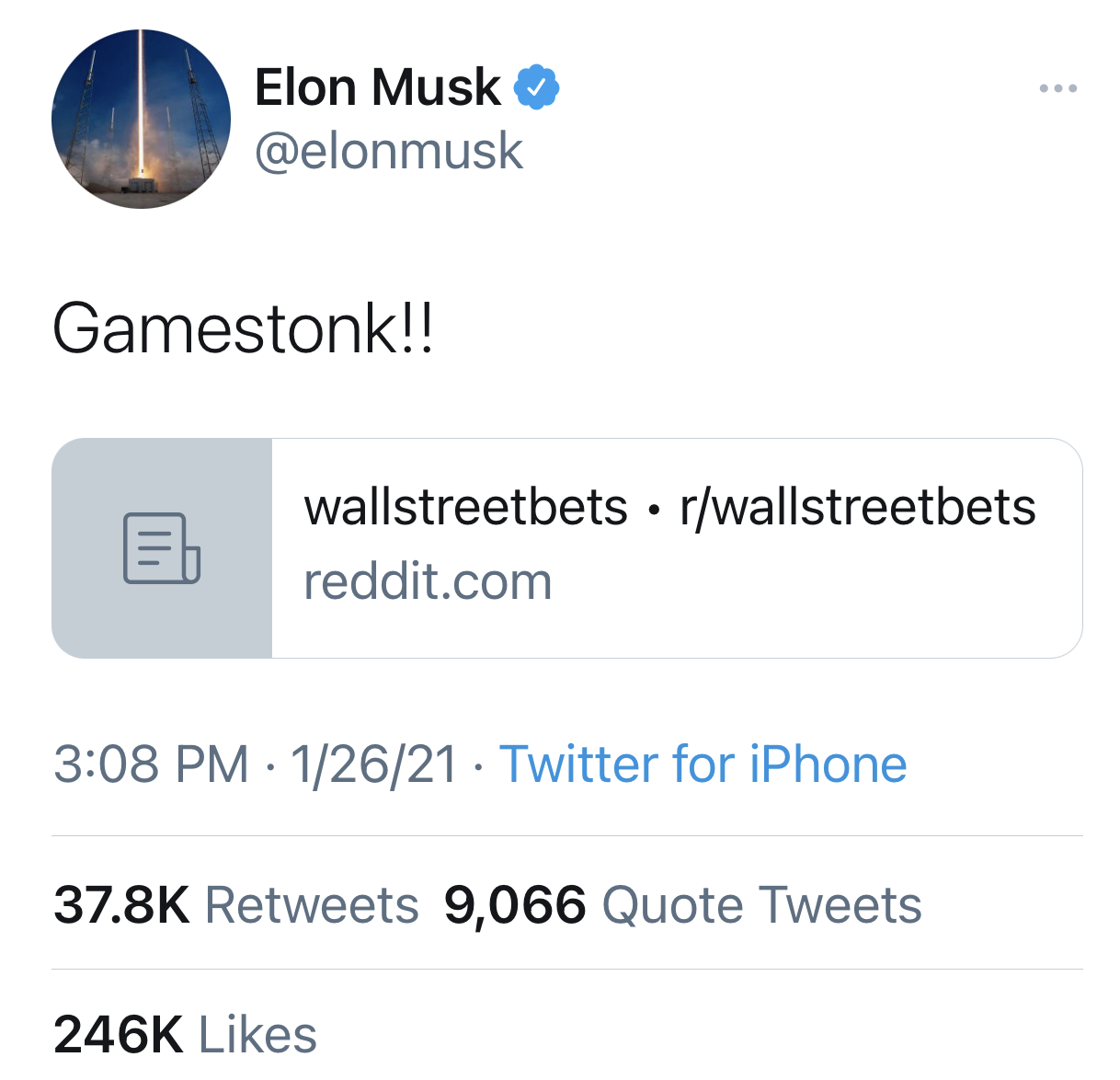On Jan 26, a tweet by Elon Musk set off a buying frenzy for shares of GameStop. Elon simply tweeted “Gamestonk!!” along with a link to a Reddit thread.
 In that thread, r/wallstreetbets recommended buying the stock which was heavily targeted by hedge funds who had large quantities of short sell orders against it. The buy orders from the retail investors ran up the price, forcing hedge fund managers to buy at the higher prices to cover their positions.
In that thread, r/wallstreetbets recommended buying the stock which was heavily targeted by hedge funds who had large quantities of short sell orders against it. The buy orders from the retail investors ran up the price, forcing hedge fund managers to buy at the higher prices to cover their positions.
The buy/buy-to-cover cycle resulted in a “short squeeze” phenomenon. Retail houses such as Robinhood and E*Trade halted trading of the stock. But not before the hedge funds lost $Billions.
Retail investors called foul, accusing the brokerage firms of protecting the rich at the expense of the individual investor. Robinhood took on an all-new meaning and the US Congress called for an investigation.
That same week, the Justice Department announced it had filed charges against an individual for interference in the 2016 election. His crime? He shared a meme.
Social media influence marketing, which used to conjure up images of someone like Kim Kardashian recommending a beauty product, has taken on a whole new meaning.
Why Influence Matters
What does this all mean for influence marketing, expected to be part of the mix for nearly 68% of all marketers in 2021?
And more important, what does it mean for B2B marketers?
According to a report by TopRank, 74% of B2B marketers agree that influence marketing improves customer and prospect’s experience with their brand.

The study confirmed what many B2B marketers had already discovered, that B2C influence marketing tactics do not translate directly to B2B.
The research also found that B2B marketers often struggle with creating strategies, integrating content, and measuring success in this territory using their own internal resources.
There are many benefits provided by using influencers to help promote your brand.
Influencers who are thought leaders in their field are followed by the product consumers who are looking for new insights, fresh ideas, and industry knowledge. Would-be customers also seek trustworthy evaluations of the vendors and products available.
When an influencer highlights your brand, it adds to your credibility. It can even help promote your company as a thought leader in your own right.
One of the other major benefits of working with an influencer is sheer reach. The influencer can amplify your own reach as much as a 1000x over your organic efforts.
While influencer posts can generate leads, and even lead to closed sales, a successful strategy matches up posts and content to each stage of the buyer’s journey.
Finding Your Who’s Who
When looking for an influencer to work with, it is important to ensure they, and their audience, align with your ideal prospects.
Audience relevance is far more important than audience size. So does the level of audience engagement. Engagement includes likes, votes, comments, and shares.

Domain expertise is also at the top of the list. While an influencer’s credentials or background are important, those attributes should not be a deciding factor in finding a fit. Influencers have built their following and reputation for a reason.
If values such as those from the social realm are important to you, then make sure the influencer aligns with those values. Since an influencer’s charisma and personality factor into the reason people follow them, their feed may reflect personal opinions outside of their domain of expertise.
Naturally, you will also want to ensure that the influencer posts regularly and is skilled in creating short-form content.
The Cost of Influence
Engaging with a social media influencer to promote your product or brand usually involves a fee paid to the influencer. This can range anywhere from around $1000 per post to as much as a staggering $1M. However, sometimes influencers will feature your brand or product without the fee if they find it compelling and it provides value to their audience.
The fee, usually derived based on the number of followers, is generally lowest on Twitter and highest on a blog, with the midpoint being posts on Facebook.
For more mature influencer programs, tools that help find, recruit and manage influencers, and measure results are a worthy investment. There are many such tools available. Some free services are available, and others range from as low as $10 per month to $1500 per month for larger accounts.
If you are just getting started with influencer marketing, you can also reach out to influencers you follow directly and see if there is a fit.
Putting it All Together
Like any successful marketing program, influence marketing should be just one piece of an integrated strategy.
As most influence marketing occurs online, integration with social media efforts is natural. Social media marketing, and by extension, influencer marketing programs should closely align with your content marketing.
Influencer marketing boosts your own content efforts via influencer amplification. However, don’t overlook the opportunity to co-create content with your influencer partners.
Aligning SEO with influencer programs is also key. Influencers, either by design or happenstance, rank for certain keywords. Make sure the words and phrases your prospects search for are also sought by your influencers’ followers.
The best results from influencer marketing occur when investing in an ongoing strategy. Only 5% of marketers who engage in intermittent projects are successful, versus a 60% success rate for those that commit to ongoing campaigns.
Successful marketers benefit from a well-rounded strategy that promotes their message through content, SEO, direct emails or messaging, social media, and offline venues.
Partnering with an influencer can be a perfect way to add credibility and amplification to these efforts.
Need help building your strategy? Town Crier can help. Give us a call at 214-732-7770, email tracy@towncriergroup.com or visit www.towncriergroup.com




